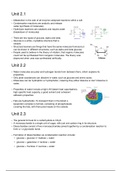Summary
Summary IB Biology Unit 2- Molecular Biology
- Course
- Institution
- Book
Summary Notes designed for the International Baccalaureate Diploma Programme. These notes are detailed yet concise, with all the information to achieve a 7 in IB Biology HL or SL. These notes were made using information from the IB syllabus, Oxford IB Diploma HL Biology Textbook, Bioninja and the B...
[Show more]



